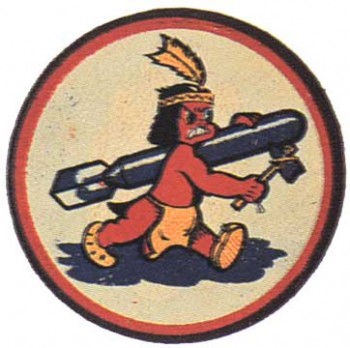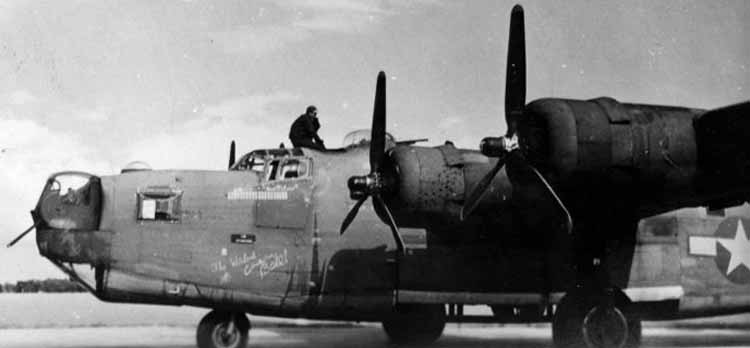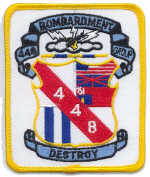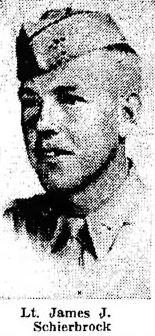The Crew of the Wabash Cannon Ball
|
|
714th Bomber Squadron, 448th Bomber Group, Heavy,
8th United States Army Air Force.
|
|
| Duty | Rank | Name | Serial Number | Outcome |
| Pilot | 1st Lieutenant | Billie C. BLANTON | 0-663471 | Returned to duty - Interned Switzerland 12th July 19944 |
| Co-Pilot | 2nd Lieutenant | James J. SCHIERBROCK
|
0-699776 | Injured - died of injuries 7th July 1944 Photograph courtesy www.americanairmuseum.com Imperial War Museum Duxford |
| Navigator | 2nd Lieutenant | George E. KLEIN | 0-712592 | Returned to duty - Prisoner of War, Germany 12th July 1944 |
| Bombardier | 2nd Lieutenant | Fred BERNARD | 0-697982 | Injured - Returned to duty (date unknown) |
| Engineer | Staff Sergeant | Adrain J. DENBROEDER | 31242442 | Returned to duty - Prisoner of War, Germany 12th July 1944 |
| Radio Operator | Staff Sergeant | Robert P. LARSON | 39407278 | Returned to duty - Prisoner of War, Germany 12th July 1944 |
| Nose Gunner | Sergeant | Paul E. SHERLOCK | 35790464 | Returned to duty - Prisoner of War, Germany 12th July 1944 |
| Right Waist Gunner | Sergeant | Bernard STELZER | 12127655 | Returned to duty - Prisoner of War, Germany 12th July 1944 |
| Left Waist Gunner | Sergeant | Armor L. McKAIN | 33506988 | Returned to duty - Interned Switzerland 12th July 1944 |
| Tail Gunner | Sergeant | Salvatore J. SPARCIO | 32839951 | Returned to duty - Prisoner of War, Germany 12th July 1944 |
When the Americans joined the Second World War East Anglia became the home to thousands of Americans who quickly transformed the countryside. The first Airfield built by the Americans was Andrews Field at Great Saling, and whilst locals would have seen many of the B26 Marauder medium bombers taking off and landing there and at Dunmow, they would also have been keenly aware of the huge B24 Liberator heavy bombers of the 8th United States Army Air Force. The area over Felsted, Ford End and Little Dunmow was the formation area for the 487th Bomb Group based at Lavenham. These huge aircraft carrying up to 8,800 lbs of bombs each would circle after take off, forming up into their precise box formations.
With so much high explosive in the air it couldn’t be long before an accident happened. On Sunday 2nd July 1944 the Air Raid Warden at Ford End Church Tower reported:
“American Liberator 12.55 hrs. Crashed at 400 yards north of main road, Dunmow to Chelmsford. East of Apple Tree Corner. Crew all baled out. 4 accounted for.”
But this Liberator wasn’t from the 487th, they had earlier flown to Belloy-sur-Somme to bomb a V weapons site. That morning the 448th Bomb Group had taken off from their base at Seething in Norfolk, formed up over the North Sea before turning for their mission to another V weapons site at Fiefs in the Pas de Calais.
Aircraft 42-109793 “The Wabash Cannon Ball” of the 714th Bomber Squadron which had already been flown on 41 combat missions was being flown by Pilot, 1st Lieutenant Billie C. Blanton when number 4 engine (outer starboard) blew an oil line, the pilot was unable to feather the engine, and the engine started to vibrate badly causing the propeller on engine number four fly off the engine hitting engine three, ruining it and the fuselage, injuring Bombardier 2nd Lt. Fred Barnard, causing a severe foot wound. Although high above thick cloud they believed they were directly over Braintree and unable to jettison the bombs.
With the aircraft critically damaged, the Bombardier
injured, and the aircraft falling out of formation Blanton radioed his base
and was ordered to bail out. The first member of the crew landed at
Rochester Farm, Great Leighs.
The records show that eight of the crew were quickly returned to duty, but Co-Pilot, James Jerome Schierbrock, from Salt Lake City, Utah, was badly injured, breaking his back in the parachute jump, and died five days later at 5 am on 7th July 1944, at the US 121st Hospital in Braintree. He is buried at the American War Cemetery near Cambridge.
James Schierbrock was originally from Canada, being born in Estavan, Saskatchewan, on 18th September 1921. His family moved to the United States as a family member needed warmer weather for their health. He was survived by a wife, Audrey and daughter, Suzanne.
Lieutenant Billie Blanton reported seeing his aircraft explode in an open field just as he passed through the cloud layer.
On the ground there must have been many startled locals as an aircraft full of fuel and bombs hit the ground. The subsequent ARP report is extremely under-stated:
“3rd July 1944, 12.48 hrs. Fire now out and bombs believed to have exploded in crash. Superficial damage, windows, ceilings etc. to 22 houses. Chelmsford RDC (Rural District Council) have matter in hand.”
David Wallis, who was just ten years old at the time and lived in Great Waltham, remembers the crash and with a gang of friends cycled up to see the crash site, although he recalls they weren't allowed near the wreckage.
For Lt. Blanton and the other seven crew members, the return to duty was on 12th July when they boarded the “Bim, Bam, Bola” with two replacement crew for a raid on Munich. This long flight ended on the border with Switzerland where separated from the rest of the Bomb Group they again baled out. Seven were captured by the German army and made prisoners of war. Lt. Blanton, and the remaining two crew members parachuted over the border and were interned in Switzerland.



